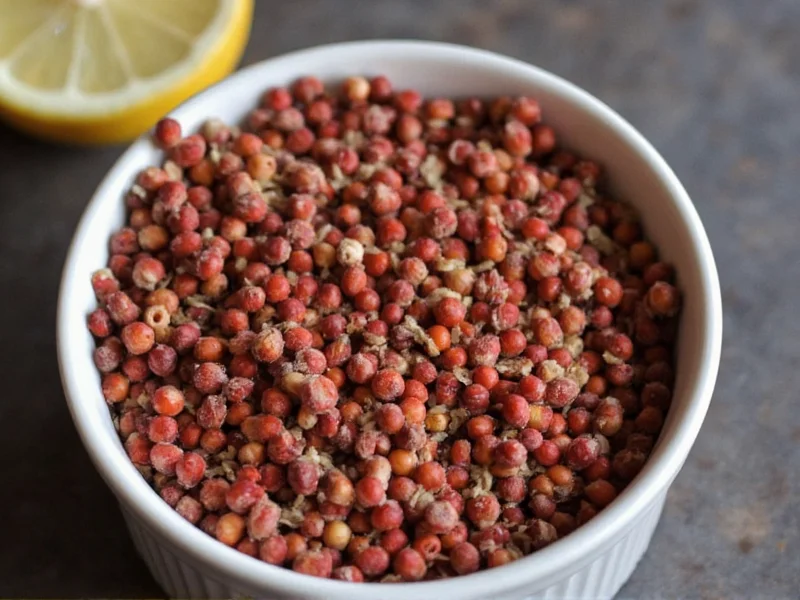Understanding peppercorn longevity requires distinguishing between actual spoilage and quality degradation. Unlike perishable foods, dried peppercorns—whether black, white, green, or pink—won't grow harmful bacteria when stored in dry conditions. However, their essential oils evaporate over time, resulting in diminished flavor and pungency that affects culinary results.
How Peppercorns Degrade Over Time
Peppercorns contain volatile oils responsible for their characteristic heat and aroma. These compounds gradually dissipate through a process called sublimation, where solid compounds transition directly to gas. Whole peppercorns lose potency at about 15% per year under ideal storage, while ground pepper loses up to 50% of its flavor within three months due to increased surface area exposure.
Signs Your Peppercorns Have Lost Quality
While not dangerous, degraded peppercorns deliver disappointing culinary results. Watch for these indicators:
- Faded aroma - Fresh peppercorns release a sharp, piney scent when crushed. Weak or absent fragrance signals significant flavor loss
- Visual changes - Look for faded color (black peppercorns turning grayish), visible moisture, or mold growth
- Taste test - Properly stored whole peppercorns should deliver immediate heat. Dull or delayed heat indicates degradation
- Texture issues - Sticky or clumped peppercorns suggest moisture exposure
Whole vs. Ground: Shelf Life Comparison
| Peppercorn Form | Optimal Shelf Life | Flavor Retention Timeline | Safety Considerations |
|---|---|---|---|
| Whole peppercorns (unopened) | 3-4 years | Maintains 80%+ flavor for 24 months | Safe indefinitely if kept dry |
| Whole peppercorns (opened) | 2-3 years | Noticeable decline after 18 months | Discard if mold appears |
| Freshly ground pepper | N/A | Peak flavor for 24-48 hours | Use immediately for best results |
| Pre-ground pepper (opened) | 6-12 months | Rapid decline after 3 months | Check for caking or moisture |
Proper Storage Techniques for Maximum Freshness
The secret to preserving peppercorn quality lies in minimizing exposure to the four enemies of spice freshness: air, light, heat, and moisture. Follow these evidence-based storage methods:
Airtight containers - Glass jars with tight-sealing lids outperform plastic containers, which can absorb odors and allow gradual air permeation. For opened peppercorns, transfer to containers with rubber gaskets.
Dark storage locations - Keep peppercorns in opaque containers or inside dark cabinets. Light exposure accelerates the breakdown of piperine, the compound responsible for pepper's heat.
Temperature control - Store at consistent room temperature below 70°F (21°C). Avoid locations near stoves, dishwashers, or other heat sources that cause temperature fluctuations.
Moisture prevention - Never store peppercorns near the sink or dishwasher. Consider adding food-safe silica packets to containers in humid climates to absorb ambient moisture.
When Peppercorns Actually Become Unsafe
While rare, certain conditions can make peppercorns unsafe for consumption:
- Mold growth - Visible fuzzy patches indicate biological contamination requiring immediate disposal
- Moisture damage - Clumped or sticky peppercorns may harbor bacteria if exposed to water
- Pantry pests - Webbing or small holes in packaging suggest insect infestation
- Chemical odors - Musty or sour smells indicate decomposition beyond simple flavor loss
Properly stored dry peppercorns pose virtually no food safety risks, but compromised storage conditions can create hazards. When in doubt about safety, follow the food safety principle: "When something seems too old or shows signs of spoilage, it's better to discard it."
Maximizing Culinary Value from Stored Peppercorns
To get the most from your peppercorns regardless of age:
- Grind just before use—even slightly aged whole peppercorns deliver better flavor than pre-ground
- Toast older peppercorns lightly in a dry pan to temporarily revive some volatile compounds
- Use degraded peppercorns in long-cooking dishes like stews where flavor extraction is more complete
- Blend older peppercorns with fresher batches to extend usable life
Special Considerations for Different Peppercorn Varieties
All peppercorn varieties share similar storage requirements but have nuanced differences:
- Black peppercorns - Most stable variety with longest shelf life due to protective outer layer
- White peppercorns - Slightly shorter shelf life as the outer layer has been removed
- Green peppercorns - Often preserved in brine; follow specific storage instructions for liquid-packed varieties
- Pink peppercorns - Technically a different plant species with more delicate essential oils
Practical Testing Method for Peppercorn Freshness
Conduct this simple freshness test: Place 5-6 peppercorns on a white plate and crush them with the back of a spoon. Fresh peppercorns will produce an immediate, sharp aroma detectable from 6-12 inches away. If you must bring the plate close to your nose to detect any scent, the peppercorns have significantly degraded.











 浙公网安备
33010002000092号
浙公网安备
33010002000092号 浙B2-20120091-4
浙B2-20120091-4